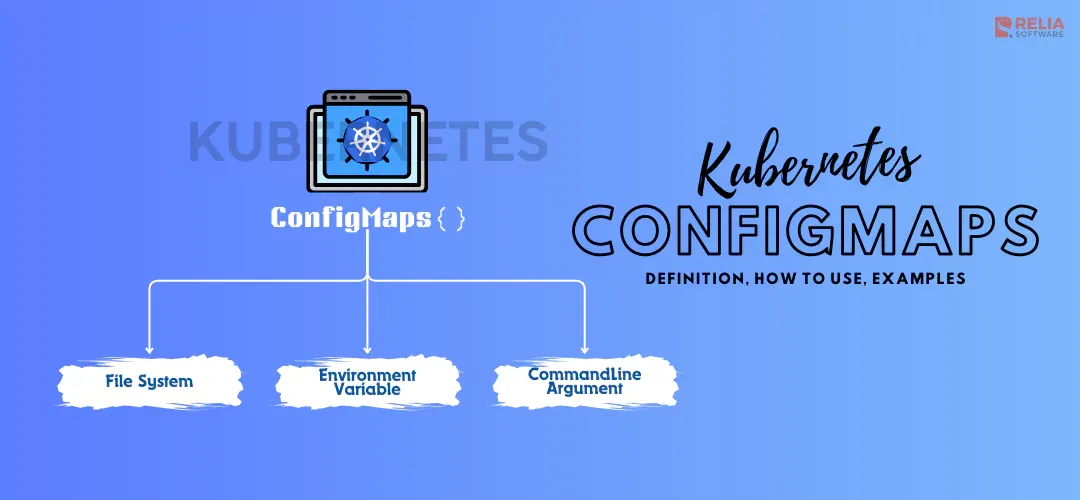In modern containerized applications, separating configuration from application code is a crucial best practice. Kubernetes ConfigMaps provides a powerful solution to this challenge by offering a way to store and manage configuration data separately from your application containers. This separation makes applications more portable, maintainable, and easier to deploy across different environments.
>> You may be interested in: Top 9 Best DevOps Deployment Tools for Businesses
What is a ConfigMap?
A ConfigMap is a Kubernetes API object that stores non-sensitive configuration data in key-value pairs. It acts as a configuration container that can be consumed by pods and other Kubernetes resources. Think of it as an external configuration file that your applications can reference.
Unlike Kubernetes Secrets, ConfigMaps are not encrypted, making them suitable for storing application settings, environment variables, and configuration files—but not sensitive data like passwords or API keys.
Look through this quick comparison to help you understand when to use ConfigMaps vs. Secrets.
| Feature | ConfigMaps | Secrets |
| Purpose | Stores non-sensitive configuration data | Stores sensitive data (passwords, API keys, certificates) |
| Data Encoding | Plain text (Base64 encoding not required) | Encoded in Base64 (but not encrypted by default) |
| Security | No built-in security | More secure, supports RBAC & encryption |
| Use Case | Environment variables, config files, command-line args | Credentials, database passwords, TLS certificates |
Why Use ConfigMaps?
Configuration Separation
-
Keeps configuration separate from application code.
-
Enables configuration changes without rebuilding container images.
-
Follows the “Configuration as Code” principle, so configurations are versioned and managed efficiently.
Flexibility
-
Supports multiple formats: key-value pairs, properties files, JSON, YAML, etc..
-
Can be consumed in various ways (environment variables, files).
-
Easy to update and manage multiple instances without restarting the application.
Environment Management
-
Simplifies managing configurations across different environments.
-
Enables consistent configuration across multiple pods.
-
Facilitates DevOps practices by automating configuration management.
>> Read more: Top 10 Configuration Management Tools For Developers
How to Create Kubernetes ConfigMaps?
There are several ways to create a ConfigMap:
- Creating from Literal Values: Useful for small configurations that can be directly passed in the command line.
kubectl create configmap app-config --from-literal=APP_COLOR=blue --from-literal=APP_MODE=production
- Creating from a File: Ideal for storing configuration files such as
.envor.properties.
kubectl create configmap app-config --from-file=config.properties- Creating from a YAML Definition: Recommended for declarative management and version control.
YAML Definition:
apiVersion: v1
kind: ConfigMap
metadata:
name: app-config
data:
APP_COLOR: blue
APP_MODE: productionCommand Line:
kubectl apply -f configmap.yamlBest Practices for Kubernetes ConfigMaps
Naming and Organization
-
Use consistent naming conventions.
-
Include environment/component information.
-
Organize ConfigMaps by component or function.
-
Use meaningful labels for better organization.
Example:
# Use clear, descriptive names
apiVersion: v1
kind: ConfigMap
metadata:
name: frontend-config # Clear purpose
namespace: my-application # Specific namespace
labels: # Proper labeling
app: frontend
environment: productionData Management
-
Keep ConfigMaps small to avoid large memory footprints.
-
Use appropriate data formats (YAML, JSON, or properties files).
-
Document configuration parameters to ensure easy maintenance.
- Store ConfigMap YAML definitions in version control for better traceability.
apiVersion: v1
kind: ConfigMap
metadata:
name: app-config
data:
database.properties: |
db.host=mysql.example.com
db.port=3306
db.name=myapp
app-settings.json: |
{
"cache.enabled": true,
"max.connections": 100
}Security Considerations
-
Never store sensitive data in ConfigMaps; use Secrets instead.
-
Implement RBAC (Role-Based Access Control) when retrieving ConfigMaps.
-
Regularly audit ConfigMap contents to detect outdated or incorrect configurations.
Update Strategy
-
To ensure application pods detect configuration changes, use checksums to trigger rolling updates:
apiVersion: apps/v1
kind: Deployment
metadata:
name: myapp
spec:
template:
metadata:
annotations:
checksum/config: $(kubectl get cm app-config -o yaml | sha256sum)Monitoring and Maintenance
-
Monitor ConfigMap usage to avoid unnecessary resource consumption.
-
Implement backup strategies for disaster recovery.
- Clean up unused ConfigMaps to prevent outdated configurations from affecting deployments.
Version Control and CI/CD
-
Treat configuration as application code.
-
Use environment-specific configurations.
-
Implement CI/CD pipelines for ConfigMap updates.
Common Use Cases with Examples
Environment Variables
This is a commonly used pattern. We inject the ConfigMap contents via environment variables so that the application can use them.
This is useful for:
- Application settings (e.g., themes, API modes).
- Feature toggles (e.g., enabling/disabling specific functionalities).
- Database or API endpoints (e.g., setting
DB_HOSTorAPI_URL).
apiVersion: apps/v1
kind: Deployment
metadata:
name: myapp
spec:
replicas: 2
selector:
matchLabels:
app: myapp
template:
metadata:
labels:
app: myapp
spec:
containers:
- name: myapp
image: nginx:latest
env:
- name: APP_COLOR
valueFrom:
configMapKeyRef:
name: app-config
key: APP_COLOR
envFrom:
- configMapRef:
name: app-configVolume Mounts
Some applications do not support environment variables and instead need configurations as files (e.g., config.json, .env, .properties). In such cases, Kubernetes allows you to mount a ConfigMap as a file inside a pod.
This is useful for:
- Configuration-driven applications (e.g., Nginx, Spring Boot).
- Complex settings stored in structured files (YAML, JSON, XML).
- Dynamic configurations that applications need to read as files.
Example:
apiVersion: apps/v1
kind: Deployment
metadata:
name: myapp
spec:
replicas: 2
selector:
matchLabels:
app: myapp
template:
metadata:
labels:
app: myapp
spec:
containers:
- name: myapp
image: nginx:latest
volumeMounts:
- name: config-volume
mountPath: /etc/config
readOnly: true
volumes:
- name: config-volume
configMap:
name: app-configTroubleshooting Common ConfigMap Issues
| Issue | Cause | Solution |
| ConfigMap values are not updating in running pods. | Kubernetes does not reload ConfigMaps automatically. | Use checksum annotations or force pod restarts. |
| ConfigMap keys not found in the application. | Incorrect reference in Deployment YAML. | Check configMapKeyRef and validate key names. |
| Application crashes on missing ConfigMap. | ConfigMap might not be created yet. | Add optional: true to configMapRef or ensure it exists before deployment. |
| File-based ConfigMap missing expected data. | Improper volume mount path. | Verify mountPath in volumeMounts. |
Conclusion
This introduction provides a foundation for understanding Kubernetes ConfigMaps and their role in container orchestration.
Remember that ConfigMaps are designed for non-sensitive configuration data. Do not store sensitive data like passwords, API keys, etc. Instead, use Kubernetes Secrets to handle sensitive information securely.
>>> Follow and Contact Relia Software for more information!
- development

